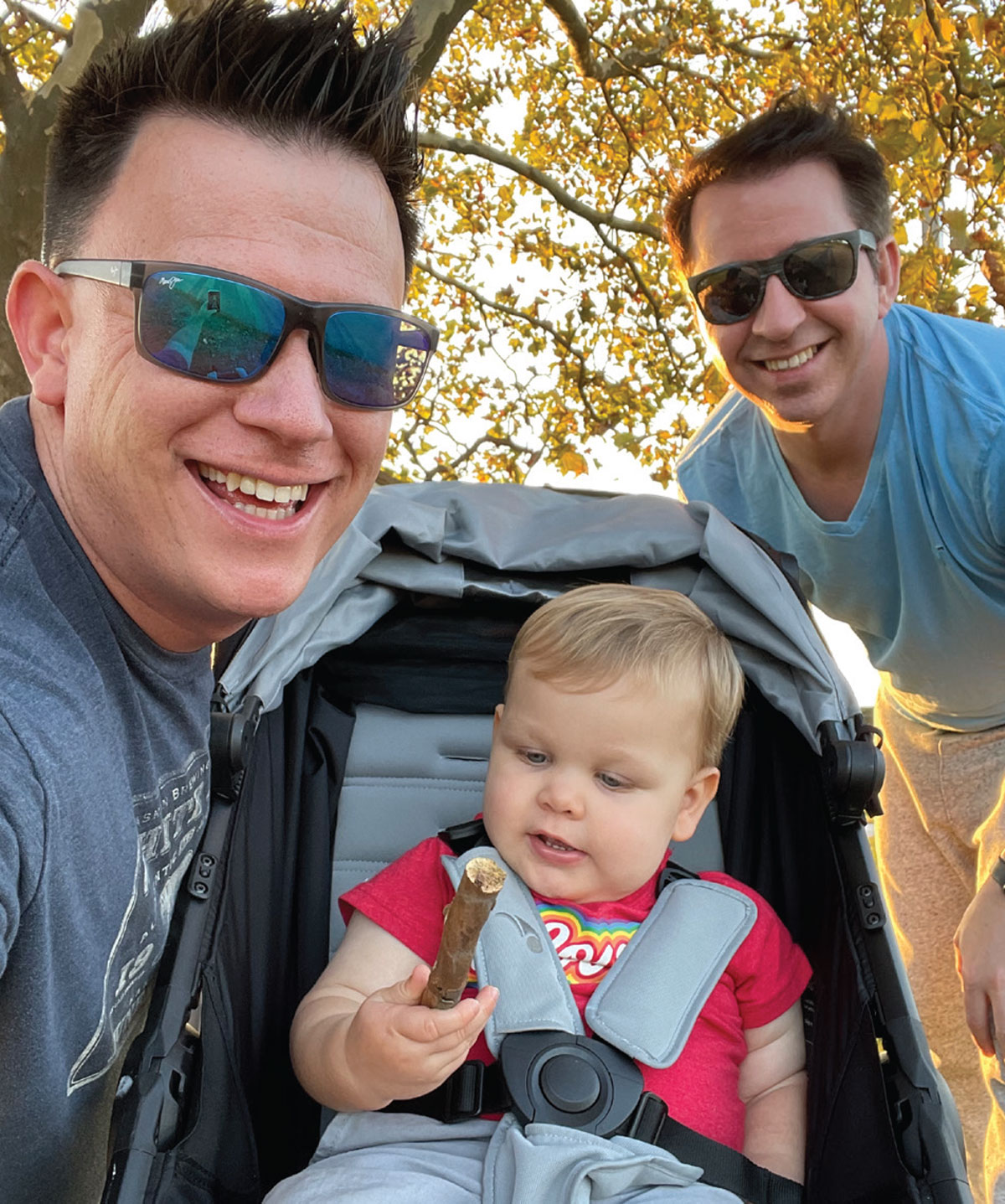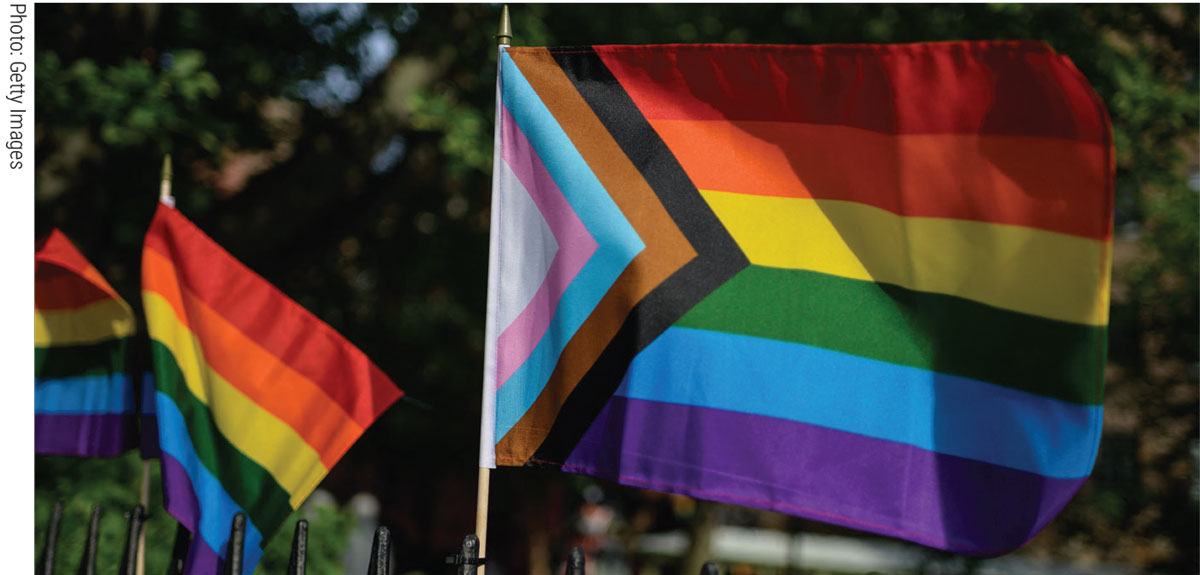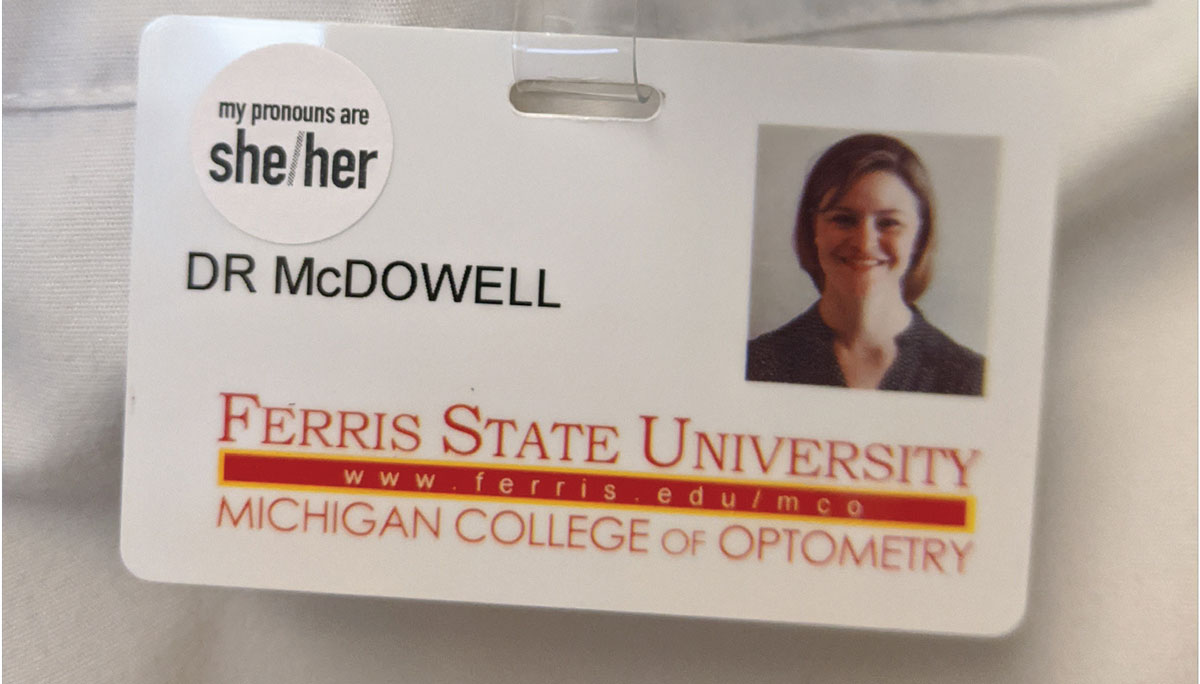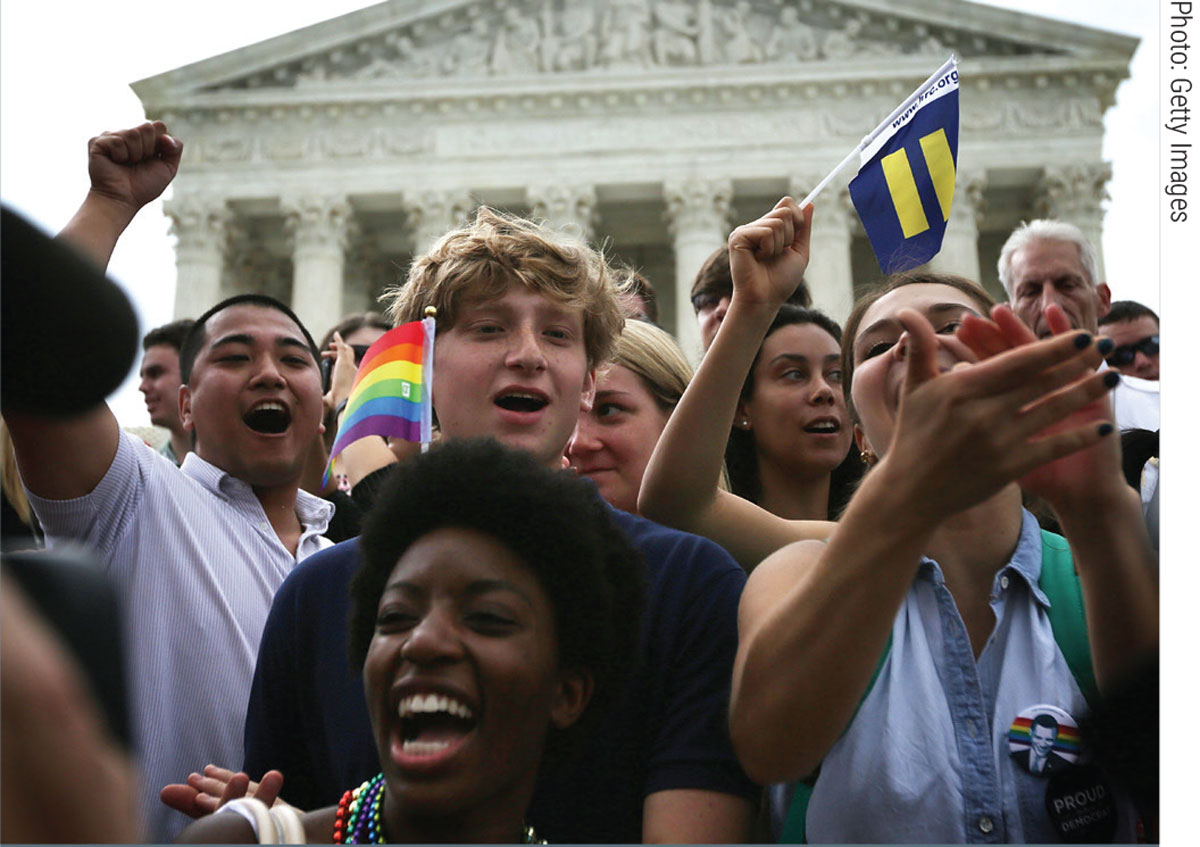Who is Your Patient?This series explores how both innate and acquired elements of identity manifest in the clinic:
|
Being an optometrist has been a rewarding job. However, when I (Dr. Roberts) graduated from school 15 years ago, I was not sure if patients would accept me for being different. I was from a small rural town where diversity was scarce and discussions of diversity and inclusion were not mainstream in culture—let alone in the optometry curriculum. At the time, I was closeted (meaning I hadn’t told anyone about my sexuality) and scared to death that my future would crumble should people know the truth about who I am and who I love. At graduation, I was just coming to grips with who I truly was, but being a part of the lesbian, gay, bisexual, transgender or queer/questioning (LGBTQ+) community frightened me. I certainly did not feel safe enough to trust a medical professional with knowing my hidden truth.
Background
Now I can look back at how far I have come: I am out, married to the love of my life, have an adopted son and a great job within the Department of Veteran Affairs. I have also been appointed the LGBTQ+ Veteran care coordinator due to my advocacy for LGBTQ+ veterans for our facility and smaller out-patient clinics. Never in a million years did I feel that I would be this embraced. Hopefully, this article will allow you as a provider to feel more comfortable with LGBTQ+ patients in your office and to enhance their experience as patients and human beings.
 |
|
Intake forms with marital status might include “significant other” or “partner” to show inclusiveness. For children, options for legal guardian(s) or caregiver(s) are more inclusive than a specific space for a mother and father. |
I will never forget having that first, honest discussion with friends, then family, then finally the medical community (in that order). Unfortunately, due to past experiences, this is the case for most people in the LGBTQ+ community.1 Most, at some point, have felt the stigma of being different in society, experienced discrimination and have psychological insult from being denied civil and human rights. Further, many have lacked family and personal acceptance of their true self.3
We have come so far in a short period of time with the legalization of gay marriage, but, like human rights movements of the past, there is still progress that needs to be made to reduce disparities and achieve full equality. The largest thing to know is that being LGBTQ+ is not a disease. However, it was only in 1987 that “homosexuality” was removed from the Diagnostic and Statistical Manual of Mental Disorders.1
In reality, the LGBTQ+ community “consists of a cross-cultural, broad range of community members that includes all races, ethnic and religious backgrounds, as well as a range of socioeconomic status.”1 Therefore, it is so important to become aware of unconscious biases as clinicians to provide the best possible care to patients. As the most recent optometric oath states, “I will provide professional care for the diverse populations who seek my services, with concern, with compassion and with due regard for their human rights and dignity.”2 The most recent updates also state, “I will work to expand access to quality care and improve health equity for all communities.”2
The three main ways that a provider can help improve the patient experience are to understand and use appropriate terminology, understand barriers to care for this population and use gender-inclusive practices within the office. In this article, Dr. McDowell and I will discuss how to increase your awareness and best enact these changes.
Using Appropriate Terms
 |
| Within your practice, consider including literature or symbols that are pertinent to the LGBTQ+ community in the waiting room. The Pride Progress Flag’s design is inclusive of marginalized racial communities as well as the transgender community. |
Understanding terminology can help build rapport with patients. This can be difficult, as terminology surrounding LGBTQ+ individuals and identity, in particular, is constantly evolving. However, both the optometrist and staff need to know what is derogatory and what is not; when in doubt, following the patient’s lead is often safe.1
Previous literature frequently cites out-of-date, derogatory or inaccurate terminology, but the good news is that there is an abundance of recent literature surrounding this topic. The following is a very brief list of some terminology that is prominent within the LGBTQ+ community that all clinicians should be aware of:1
- Ally: a heterosexual and cisgender person who supports equal civil rights, gender equality and LGBTQ+ social movements, challenging homophobia, biphobia and transphobia.
- Bisexual: Individuals that are attracted to both males and females.
- Cisgender: Denoting or relating to a person whose sense of gender identity corresponds with their assigned sex at birth.
- Coming out: Sharing gender or sexual identity publicly.
- FTM (female to male): Assigned female sex at birth but identifies as male, sometimes referred to as a transgender male.
- Gender: A person’s internal sense of being male, female or somewhere in between, often self-identified by age six or earlier.
- Gender non-conforming (GNC) or non-binary (NB): Gender behaviors that do not strictly align with feminine or masculine binaries.
- Intersex: Individuals born with anatomical sexual characteristics that are not typical of male or female binary notions.
- MTF (male to female): Assigned male sex at birth but identifies as female, sometimes referred to as a transgender female.
- Queer: A general term that refers to lesbian, gay, bisexual, transgender and queer individuals (sometimes considered derogatory but often thought to have been reclaimed by those in the LGBTQ+ community).
- Questioning: Individuals uncertain of their gender identity and/or sexual orientation.
- Sex assigned at birth: Sex assigned based on infant’s external genitalia, chromosomal makeup and/or hormone prevalence.
- Sexual identity: An individual’s description of their own sexuality.
- Sexual orientation: An individual’s sexual identity concerning their gender attraction.
- Transgender: Individuals whose gender identity is different than their sex assigned at birth.
- Transition: An individual’s psychological, medical or social process of transitioning from one gender to another. This is individualized and may include one, some, all or none of these transitions.
Barriers to Care
Optometrists are often on the frontline of healthcare. By being more culturally competent with the LGBTQ+ population, we can improve health outcomes by eliminating disparities this population often faces. The following includes a list of challenges in this population, with each of these statistics higher and more prominent in racial minority groups:3
- LGBTQ+ youth are more likely to be homeless and are two to three times more likely to commit suicide.
- Lesbians and bisexual females are more likely to be overweight or obese.
- Gay men are at a higher risk of HIV and other sexually transmitted infections (STIs), especially among communities of color.
- Transgender individuals have a high prevalence of HIV/STIs, victimization, mental health conditions, higher risk of suicide and are less likely to have health insurance than heterosexual or cisgender members of the LGBTQ+ community.
- Elderly LGBTQ+ individuals face additional barriers to health because of isolation and lack of social services and culturally competent providers.
- LGBTQ+ populations have the highest rates of tobacco, alcohol and other drug use.
While none of the above are inherent to being an LGBTQ+ individual, the frequent abuse and risk of discrimination of “coming out” contributes to the astounding rates of depression and suicide. As providers, we can ask if the patient has access to appropriate mental health services, and be aware of local support groups and inclusive primary care providers.
An Inclusive Practice
 |
|
One of the smallest steps to improve inclusivity while yet making a large impact is the use of pronouns; for example, in staff badges. Have stickers and pins readily available to attach to a clinic badge or white coat to keep your pronouns visible and remind patients that you have a gender-inclusive practice. |
In practice, patient paperwork and forms need to reflect an inclusive environment, since paperwork is one of the first things that a patient sees upon entering the office. For all patients, providing space for legal name and nickname or preferred name is common, and still appropriate for the LGBTQ+ population. Sex should be listed as male, female or other. A more complete option is to have both birth sex and self-identified gender identity, with options for pronouns.
Intake forms with marital status might include terminology such as “significant other” or “partner” (instead of husband/wife) to show a practice’s inclusiveness. For children, options for legal guardian(s) or caregiver(s) are more inclusive than a specific space for a mother and father.
One of the smallest steps to improve inclusivity, while yet making a large impact, is the use of pronouns that match the patient’s identity. To most heterosexual cisgender individuals, this may seem like an unnecessary step. However, to the transgender and GNC/NB community, using appropriate pronouns validates who they are.
When a person is misgendered, it adds to the challenges and burdens that they already face. Worst of all, it brings up feelings of dysphoria, anxiety, stigmatization, lowered self-esteem and embarrassment. Simply using gender-affirming pronouns lowers rates of suicide and is an easy way to have a hugely positive impact on your patients’ life.4
In sharing pronouns, it is also becoming common practice in group introductions to include pronouns. This shows anyone in the group that may be GNC that they will not be the only ones to reveal their pronouns. This creates a supportive environment for employees that will also extend to improved patient care. To show patients this inclusivity, include pronouns on both websites and business cards. There are also stickers and pins readily available to attach to a clinic badge or white coat to keep your pronouns visible and remind your patient that you have a gender-inclusive practice.
One frequent question we get is, “How do we use pronouns in the exam room?” Your pronoun can be added as part of your introduction. An example to the patient could be, “Hello, I’m Dr. Matthew Roberts, your optometrist, and my pronouns are he/him/his,” or, “Hello, I’m Dr. Paula McDowell, and my pronouns are she/her/hers.”As the leader in the clinic, it is our job to start the meeting properly, even in one-on-one interviews.
If there is someone that identifies as GNC, this shows that person they are in a safe environment. Also, if a patient has marked that they are GNC on their form, as their optometrist it is acceptable and encouraged to ask directly, “What are your pronouns?” Of course, it is always appropriate to use a patient’s preferred name or nickname in a face-to-face setting as well.
There are some challenges with preferred names in that the patient’s current name may not match with legal paperwork or their previous name recorded in the office. An inclusive practice will use the patient’s nickname or preferred name and be sure not to use a name linked to an identity that the patient no longer identifies with.
To use the old, or dead, name is an offensive practice called “deadnaming,” which should be avoided whenever possible. However, while a nickname should be easy to record in the chart and use in patient conversations, the legal paperwork may still have to use the previous name for insurance submissions. It is useful to inform patients of this discrepancy so that they are aware that paperwork from the insurance company may use the old name, and make sure that documentation is clear in the chart for staff as well.
Within the practice, include literature or symbols that are pertinent to the LGBTQ+ community in the waiting room. Common symbols include the equal sign from the Human Rights Campaign, or the rainbow flag, which has been redesigned itself to be more inclusive as the Progress Flag. The smallest symbol will be noticed by patients without needing to have a large-sized display. Also, ensure that there is racial diversity within displays and include both transgender and same-sex couples.1
Interactions
 |
|
Being more culturally competent with the LGBTQ+ population can improve health outcomes by eliminating disparities this population often faces. |
Although an optometrist may be aware of their own biases, it is important to educate your staff about appropriate interactions and language. As they often interact with patients more frequently than the doctor, what your staff says and does places a large impact on the practice. Encourage them to practice in becoming comfortable discussing gender identity, and include periodic trainings, tutorials or role-play to help increase comfort.2
Other strategies may not be as obvious to implement but can still enhance inclusivity. First and foremost, be aware. If there is derogatory language occurring in the practice (by either staff or patients), do not escalate, but educate. Correcting attitudes takes time and it can be difficult being aware of what one’s biases are.
Second, be an ally to your staff and your patients. By taking into consideration the steps listed here, an optometrist can help build a better community and improve health outcomes.
Third, ask questions to those within the LGBTQ+ community to become more aware of their needs. Those within the community do not take offense to someone trying to better understand.
Fourth, make a list of internal biases you may have. This is the best way to try to work through them to ensure equal care is given to each patient, no matter the background.5
Finally, get involved in your community. If the community you serve has a Pride event, support it by getting a booth, for example. This helps the practice show its stance as an ally for the community. The vision information that you can provide is invaluable and knowing that there is a safe eye care practice for LGBTQ+ individuals to visit when needed is one way to reduce barriers to care.4
Takeaways
The diversity within the LGBTQ+ community is part of what makes it so unique. Being more aware of internal implicit biases makes a better clinician. Even as an individual within the LGBTQ+ community, I (Dr. Roberts) have become aware of my own biases, but continuing to educate and now providing education to others has made me a better clinician and a better father. As the two of us have seen optometry become more diverse, all of us need to meet that challenge with open arms.
Dr. Roberts practices at the VA Battle Creek Medical Center, where he is the team lead of the Low Vision Clinic and the LGBTQ+ Veteran Care Coordinator. He also practices at the Unified Clinics at Western Michigan University in Kalamazoo, MI, where he is also an adjunct professor, a fellow of the American Academy of Optometry and chair of the Michigan Optometric Association’s Continuing Education Committee. He has no financial disclosures.
Dr. McDowell is chief of pediatrics, pediatric residency supervisor and professor at Michigan College of Optometry at Ferris State University in Big Rapids, MI. She is a fellow of the American Academy of Optometry, an investigator for the Pediatric Eye Disease Investigator Group and chair of the Michigan Optometric Association’s Children’s Vision Care Committee. She has no financial disclosures.
1. Bass B, Nagy H. Cultural competence in the care of LGBTQ patients. StatPearls. www.ncbi.nlm.nih.gov/books/NBK563176/. October 9, 2021. Accessed November 12, 2021. 2. American Optometric Association. Ethics & values. www.aoa.org/about-the-aoa/ethics-and-values. Accessed November 12, 2021. 3. Office of Disease Prevention and Health Promotion. Lesbian, gay, bisexual and transgender health. Healthy People 2020. www.healthypeople.gov/2020/topics-objectives/topic/lesbian-gay-bisexual-and-transgender-health. Last updated October 27, 2021. Accessed November 12, 2021. 4. Gelpi M, Fidas D, Perrou M, et al. What’s your pronoun? strategies for inclusion in the Workplace. Out & Equal. outandequal.org/whats-your-pronoun-strategies-for-inclusion/. May 2020. Accessed November 12, 2021. 5. Heistad K. Unconscious bias challenge. Culture Coach International. qstream.com/wp-content/uploads/2020/03/Unconscious-Bias-Challenge.669cf2af4ed44a81d7f97bff3ddbb66a.pdf. August 9, 2019. Accessed November 12, 2021. |


